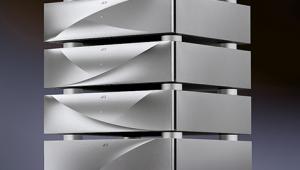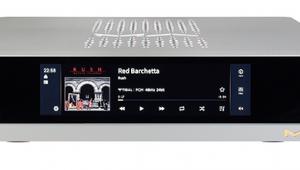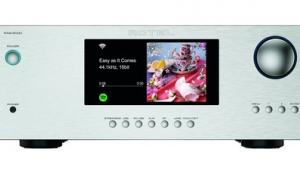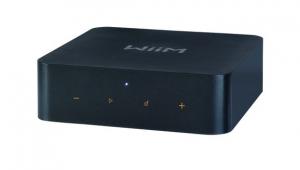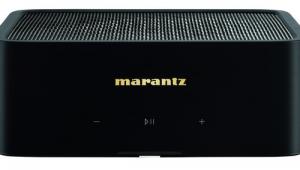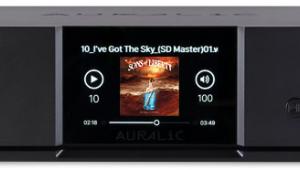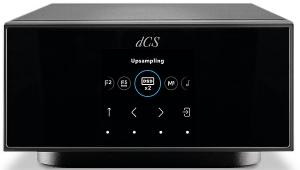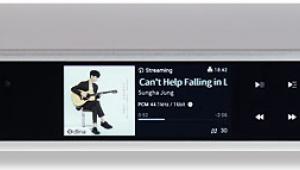Bricasti M3 Network Attached DAC

 With trickle-down tech from the flagship M1, a custom DSD DAC plus network and headphone amp options, Bricasti's M3 looks like the new go-to star of the range
With trickle-down tech from the flagship M1, a custom DSD DAC plus network and headphone amp options, Bricasti's M3 looks like the new go-to star of the range
With its upgraded M1 Dual Mono DAC now in 'Classic' form and selling in the UK at £9499, Bricasti has also announced a more affordable alternative, but still offering 'an incredible array of performance'. The basic M3 USB DAC is offered at £5399, but this increases to £6999 when fitted with its DNLA/UPnP-compatible network streaming card and new headphone amplifier option. The latter includes both 4-pin balanced XLR and 6.35mm single-ended jack outputs, and is available as a return-to-factory retro-fit option as the front fascia requires some reworking.
The new M3 features two separate D/A channels using the classic Analog Devices AD1955 DACs for LPCM and a proprietary bitstream DAC solution to handle DSD inputs. The circuitry is fully balanced throughout – including the volume control – and there are independent linear power supplies for both the analogue and digital cores of the product. The elegant, almost soft lines of the M3's alloy casework disguise what is a very purposefully built unit that, at 355x64x286mm (whd) and weighing 4.5kg, is rather bigger than our pictures might suggest.
Pro Heritage
Its casework is all CNC-machined from solid aluminium, black anodised and with laser etched legends. The M3 presents a flat front and rear face, unlike the sculpted form of the flagship M1 and its gold-plated limited edition variant [HFN Oct '16], and looks all the better for that. It sits on four 60mm-diameter non-adjustable feet with rubber inserts. The twin ventilating top-plates might, however, have been more domestic-friendly in black, rather than silver grey and are inset with a dozen countersunk fixing screws.
The overall aesthetic reflects Bricasti's very first product, the M7 Stereo Reverb processor designed for use in recording studios. The company was begun back in 2004 in a converted mill in Shirley, Massachusetts, by two former Lexicon employees, Brian Zolner and DSP software designer Casey Dowdell. A critical listener, Zolner's touchstone was the acoustics of Symphony Hall Boston, and its itinerary of fine-tuning and component choice is still determined at Bricasti by listening tests. The company also cooperates with AeVee Labs, New Haven, for its hardware engineering. Its M1 DAC appeared in 2011 [HFN Jun '11] and a well-received 200W/8ohm fully balanced monoblock followed in 2015. Bricasti's domestic lineup also includes 125W and 150W stereo amplifiers.

Back to the M3, and that large silver-white rotary is not only a gain control but is also used in conjunction with some of the fascia buttons. 'Input' is revealed as five choices on the display; 'Status' includes digital filter selection, display dimming, DSD conversion mode and phase inversion; 'Level' offers 1dB steps over a –99dB to +6dB range plus mute; 'Reference' remembers your preferred listening level with a long press. If you set the M3 to '0dB' then it defaults to bypass mode for direct output into a partnering preamp. An optional line-of-sight remote handset matches the M3's styling (£529) and duplicates all key functions, including volume.
While the original M1 had no USB-B input, although this was added later, the M3's USB and network inputs support up to 384kHz/24-bit LPCM (a downloadable driver is needed for PCs), DSD64 and 128. Additional inputs include AES/EBU, coaxial and Toslink optical S/PDIF. Both single-ended (RCA) and balanced (XLR) analogue outputs are fitted. Finally, while the M1 has no fewer than 15 digital filter options these are condensed to a choice between linear and minimum phase fast roll-off types in the M3. It also has a custom single-bit converter so that DSD inputs are not converted to LPCM.
![]() Full Colours
Full Colours
With the M3 connected via USB to my MacBook Pro running Audirvana 3.5, my initial listening proved very enjoyable via the headphone output using my trusty Beyer Dynamic T1 [HFN Aug '13] cans, before moving onto my main DNM PA3 power amp and Quad ESL-57 system. Santtu-Matias Rouvali has reached Vol 2 in his Sibelius Symphony cycle with the Gothenburg SO [Alpha ALPHA574; 48kHz/24-bit] and this is an eminently straightforward account. With the linear phase filter engaged, my first impression was of a smooth presentation where all the subsidiary detail could be heard, though overall it was somewhat bland.
Changing to the minimum phase alternative brought an obvious improvement – the soundstage shifted slightly but the rather sweet sound and fine production by Jens Braun was, from a tonal perspective, so much more involving. The same effect was also shown with the remarkable young Italian pianist Filippo Gorini playing late Beethoven sonatas [Alpha 591; 192kHz/24-bit], recorded in the Beethoven Haus Bonn.



